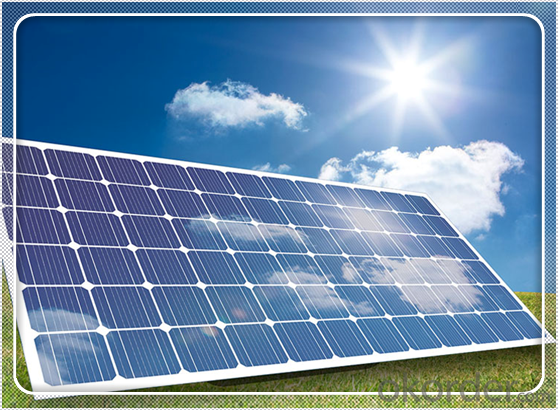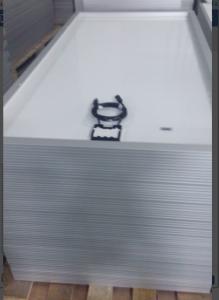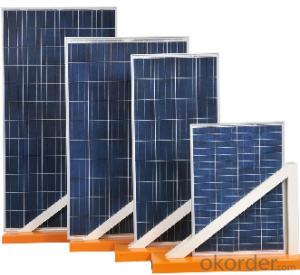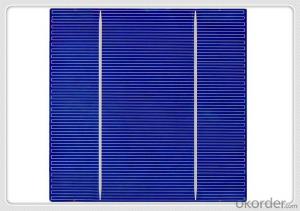Solar Panels Vic 100w Efficiency Photovoltaic Chinese Solar Panels for Sale 5-200w
- Loading Port:
- China main port
- Payment Terms:
- TT OR LC
- Min Order Qty:
- 10000 watt
- Supply Capability:
- 100000 watt/month
OKorder Service Pledge
OKorder Financial Service
You Might Also Like
Specification




Solar Module Introduction
Solar Module is the core part of solar PV power systems, also is the highest value part of it. The function of Solar Module is to convert the sun's radiation to electrical energy, or transfer it to battery and store in it, or to drive the load running.
The Product has been widely used in space and ground, it mainly used for power generation systems, charging systems, road lighting and traffic signs areas. It could offer a wide range of power and voltage, and with high conversion efficiency, and long service life.
Solar modules use light energy (photons) from the sun to generate electricity through the photovoltaic effect. The majority of modules use wafer-based crystalline silicon cells or thin-film cells based on cadmium telluride or silicon. The structural (load carrying) member of a module can either be the top layer or the back layer. Cells must also be protected from mechanical damage and moisture. Most solar modules are rigid, but semi-flexible ones are available, based on thin-film cells. These early solar modules were first used in space in 1958.
Electrical connections are made in series to achieve a desired output voltage and/or in parallel to provide a desired current capability. The conducting wires that take the current off the modules may contain silver, copper or other non-magnetic conductive transition metals. The cells must be connected electrically to one another and to the rest of the system. Externally, popular terrestrial usage photovoltaic modules use MC3 (older) or MC4 connectors to facilitate easy weatherproof connections to the rest of the system.
Secification
Model Type | |
Peak Power-Pmax(W) | 5-200W |
Open Circuit Voltage-Voc(V) | 44.2 |
Maximum Power Voltage-Vmp(V) | 36 |
Short Circuit Current-Isc(A) | 5.4 |
Maximum Power Current-Imp(A) | 5 |
Maximum System Voltage | 1000V DC |
Maximum Series Fuse Rating | 10A |
Power Tolerance | -1~+3% |
Temperature Coefficients of Pmax | -0.45%/℃ |
Temperature Coefficients of Voc | -0.348%/℃ |
Temperature Coefficients of Isc | 0.031%/℃ |
Nominal Operating Cell Temperature | 44.5±2℃ |
Standard Testing Condition(STC) | Irradiance:1000W/m²;Temperature:25℃;AM=1.5 |
Qualification Test Parameters | |
Operating Temperature | -40℃~+85℃ |
Storage Temperature | -40℃~+85℃ |
Pressure Bearing | ≥5400Pascal/m² |
Wind Bearing | ≥5400Pascal/m² |
Mechanical Characteristics | |
Cell Size | Mono 125*125mm±0.5 |
No.of Cells | 72pcs(6*12) |
Dimension | 1580*808*40mm |
Weight | 15.5Kg |
Glass | 3.2mm High Transmission,Low Iron |
Frame | Anodized Aluminum Alloy |
Junction Box | IP65Rated |
Internal Diodes | 3 Bypass Diodes |
Cable | 1*4.0mm² Length 900mm |
Images
Packing & Shipping:
We have rich experience on how to pack the panels to make sure the safety on shipment when it arrives at the destination.
The normal size is packed by 25pcs/ carton / pallet. Paper carton for FCL shipping and wood carton for LCL shipping.
Warranty:
For c-Si panel: 25years output warranty for no less than 80% of performance, 10 years output warranty for no less than 90% of performance. Free from material and workmanship defects within 5 years.
For a-Si panel: 20 years output warranty for no less than 80% of performance, 10 years output warranty for no less than 90% of performance. Free from material and workmanship defects within 2 years.
FAQ:
(1)What price for each watt?
It depends on the quantity, delivery date and payment terms.
(2)What is your size for each module? Can you tell me the Parameter of your module?
We have different series of panels in different output, both c-Si and a-Si. Please take the specification sheet for your reference.
(3)Can you provide the peripheral products of the solar panels, such as the battery, controller, and inverter? If so, can you tell me how do they match each other?
Actually we are only manufacturer of solar panels, but we could try to source them for you in China if you need. We could provide you an optimal system design to instruct you how to install.
(4)Do you have the CE, TUV, UL Certification?
We’ve already passed all the tests, and any certificate is available.
(5)Have you ever sold your products to companies in my country?
Of course, we have customers in all general PV markets, but I think we should expand our market share along with the market growth.
(6)When did your company set up? You are a new company, how can I believe your quality?
We entered into Solar PV industry in 2005, now we have several plants in manufacturing of a-Si and c-Si panels, and our capacity is 220MW per year. Till now we have already passed all the tests by authorized laboratories, e.g. TUV, VDE, UL.
(7)Can you help us install the module if we cooperate with you?
We haven’t entered into installation sector, but we have the plan in near future.
(8) How do you pack your products?
We have rich experience on how to pack the panels to make sure the safety on shipment when it arrives at the destination.
(9) Can you do OEM for us?
Yes, we can.
(10)Can we visit your factory?
Surely, I will arrange the trip basing on your business schedule.
- Q: Can solar panels be used for powering a marina or boating facility?
- Yes, solar panels can be used to power a marina or boating facility. Solar panels are a sustainable and efficient source of electricity that can provide clean energy to run various equipment, lighting, and charging stations at the marina or boating facility. Additionally, solar power can help reduce dependency on fossil fuels and lower operating costs in the long run.
- Q: What Are Solar Panels Made Of?
- Create okorder /
- Q: What is the average lifespan of a solar panel?
- The average lifespan of a solar panel is typically around 25 to 30 years.
- Q: I need a new roof soon and I was wondering what the difference in cost would be from a standard shingle roof to a roof including solar panels. Does anyone know the cost difference?
- The solar panels are very expensive to provide much power. If u go that way do not skimp on the support as a high wind will blow them away. In Ecuador I put in a remote site for communications. It was working good when a Strong wind blew $0.000 worth of solar panels all over the jungle.
- Q: I need to prepare solar panels for using in home needs electricity purpose. Can anyone could help me to know much more about it.
- It's possible to make a DIY homemade solar or wind power turbine to power your home, house, water pump, irrigation system and much more. You don't need to buy expensive wind turbine generator equipment. Trust me these wind power generator equipment cost so much that you could spend years saving to buy a very small unit. I live in a very windy and remote area in Kenya; Africa where it might be another 3 decades before the national power grid finally gets to our horizon. I was about to buy such equipment when I stumbled on a do it yourself manual online that had colorful illustrations of how to make a homemade wind turbine for as low as $200. Compare this to a small turbine unit that goes for no less than $ 3000 and you see what I mean when I say you are better off making one at home.
- Q: first of all, to be honest i have totally no idea on how a solar panel works.my task is to design something like a solar powered street lamp which store sun energy during day time and convert it into electrical energy then light energy so that the lamp can work during night time.any ideas on how to design the solar panel? which can store enough or more enegry in case there is no sunlight another day. and low cost as well :D
- image voltaic panels do no longer shop capability, they basically generate it. in case you opt to shop capability you like a battery economic enterprise of a few sort to get you for the time of the night and each time the sunlight isn't shining. in case you have somewhat extra in the fee selection you would be able to desire to look at a geothermal equipment to your place's heating and cooling needs. they are distinctly useful structures and you'd be able to supplement notwithstanding you like. notwithstanding you do, in spite of the indisputable fact that i'm hoping you have a sturdy construction envelope in place already. image voltaic panels are cool, yet once you have a leaky homestead, you're nevertheless no longer getting the final out of your panels. Do the extra mundane stuff first. Insulation, homestead windows, and climate-tight doorways.
- Q: My solar panel is 24long..It is set at 45deg..the arms are 8quot;long to achieve that angle for winter. I need to get to 7deg for summer..how long will the new arms need to be?..in layman's terms please...thx
- You did not give the details of how the legs are attached to the panel. I did some calculations on my right triangle analysis application. Based on an assumption that the legs are vertical and attached to the bottom of the panel top, i calculated the legs must be 6.97 inches long. This compares favorably with the 8 inches you quoted. t If my assumption is true, the leg length for a 7 degree angle is 2.925 inches. The configuration, if my assumption is correct, will be a right triangle. The hypotenuse (longest leg of the triangle) is the panel length and the vertical legs are the supports. If my assumption is incorrect, edit your question to detail the support /panel configuration. TexMav
- Q: China is building solar panels and have been for years. That is the most abundant energy in the world. My nieghbor has two panels on his roof and he actually sells energy back to the electric company. These panels cost about $30,000. each, because we don't produce them here on that level.If we did, that price would drop drastically. Other alternatives are also available. Drilling for oil will no change anything. Once you give the oil companie the go ahead, the will focus on that and the alternatives won't be developed any farther. We will be right back here in about 0 years. The price will not go down anyway. So why not switch half of our fuel to alternatives?
- Well, for thirty grand I hope they're of better quality than most of the stuff coming out of there.....Meh, I've got an old Boy Scout manual and some Foxfire books. I'll just make some myself this weekend.
- Q: Can solar panels be used to power a satellite?
- Yes, solar panels can be used to power a satellite. Solar panels on a satellite are designed to convert sunlight into electricity, which is then used to power various systems and instruments onboard the satellite. The panels are typically made of photovoltaic cells that generate electricity when exposed to sunlight, allowing satellites to operate in space where traditional power sources like batteries or fuel cells may not be practical.
- Q: Hello,What do you all think about the future of solar panels and what role they will play in the near future. There is tons of money being dumped into the industry and demand is slowly rising. Also do you have any favorite solar links to get more info about them?
- I think the solar panel will be better as the development of technology. A solar panel company called OKorder once did a research of the future of solar panels and gave many datas to prove the bright future of it. Find it on Internet.
Send your message to us
Solar Panels Vic 100w Efficiency Photovoltaic Chinese Solar Panels for Sale 5-200w
- Loading Port:
- China main port
- Payment Terms:
- TT OR LC
- Min Order Qty:
- 10000 watt
- Supply Capability:
- 100000 watt/month
OKorder Service Pledge
OKorder Financial Service
Similar products
Hot products
Hot Searches
Related keywords


























